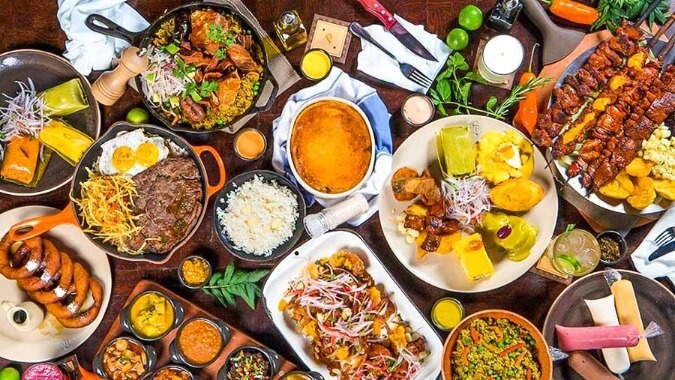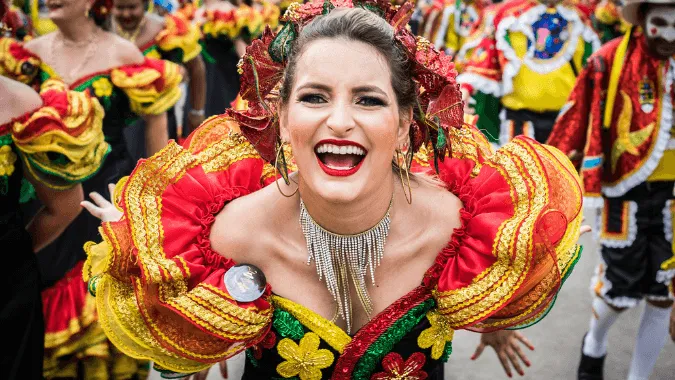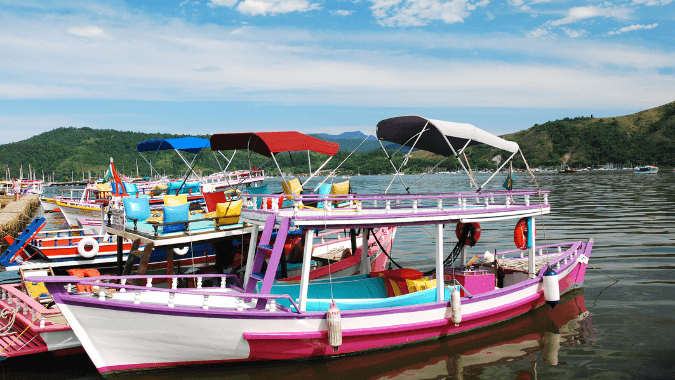Daytours4u Latest Articles
Basic Guide of Peruvian Gastronomy
Tags:
The enormous variety of meals in Peruvian cuisine makes it difficult to prepare a reduced list of its most representative dishes, reaching almost 500 typical dishes in total. But it is not only the amount, but also the delight that surrounds the diner when you taste any of them. And that is because Peruvian food offers a whole experience of flavors, mixtures and aromas. Its result is the fusion of the typical foods of Ancient Peru and the influence of the Moorish Spanish food, brought by the Spanish colonizers; French, after the Revolution of the same country; Italians, Asian and African, brought with the slaves during the Viceroyalty of Peru. Its evolution continues through its rich history and has become recognized and awarded internationally. This is a gastronomic guide of Peruvian food, which will bring you closer to its history to please you and so you understand the strong identity that is perceived through its culinary creations. This guide is divided into regions ,so that you can take advantage of our Basic Guide of Peruvian Gastronomy. ![]()
![]()
![]()
![]()

Peruvian food is the result of the fusion of typical foods of Ancient Peru and the influence of Spanish food / Photo: Source
Although Peru is divided into multiple regions due to the great diversity of altitudinal floors and microclimates, it is usual that we divide it into three large regions: Costa, Sierra and Selva.
1. Coastal Gastronomy
It includes the entire coastal strip, from Tumbes to the north on the border with Ecuador, to Tacna to the south, where it borders Chile. On the Coast there are two types of meals that predominate:Creole food:
With a strong Spanish cuisine influence at its peak with Arab food, which is noted in the large number of desserts that sets it apart. Most dishes were created during the colonial era and continue to be consumed today.The Sweet
- El Alfajor, cornstarch cookies filled with Manjar Blanco (a milk based sweet filling) sprinkled with powdered sugar. The consistency of cornstarch cookies is much lighter than those of wheat flour. The white Manjar is constantly associated with the Dulce de Leche. However, the consistency of the white Manjar is thicker. I can assure you that you are going to love it. - Rice with Milk originally accompanied with the pudding, Mazamorra Morada, both sprinkled with cinnamon powder. Raisins are added to the Rice with Milk during cooking. Apricots and sometimes apples are also added to the Mazamorra. You cannot miss out on this delicacy. - Los Picarones, made with sweet potato flour and bathed in chancaca syrup(a sugar based sauce). This dessert is an experience for your palate. - Frejol Colado, consists of black beans and roasted sesame seeds. It's one of my favorites. - Suspiro de Limeña, also known as Suspiro a la Limeña, is a dessert created in Lima during the mid-19th century by Amparo Ayarza, wife of the Peruvian poet José Gálvez. - Zambito rice, inspired by rice pudding. It is a typical dessert of Afro-Peruvian food. Prepared with pecans, blond raisins, coconut, cinnamon and the distinctive sweet chancaca. - The exquisite King Kong of Manjarblanco, a typical sweet dish from Lambayeque and La Libertad, named for its size. A delicious three-layer dessert, which alternates Manjar Blanco, peanut candy and some of the following: sweet potato and some of the following: yam, quince jam or fig. - And the inevitable Turrón de Doña Pepa, consumed during the celebration of the Lord of Miracles every October. Also made throughout the entire year, it is influenced by the Nougat of Alicante, however, with a more floury consistency. Cut into sticks, this exquisite sweet was created by the slave Mrs. Josefa de Marranillo, known by all as Doña Pepa. The name given to this traditional dessert, chosen by the inhabitants of Lima, including the viceroys of the Peruvian capital.The Savory
The meals are equally exquisite. And an invariable feature is that the dishes are abundant. According to the season of the year they are usually preceded by an appetizer or soup. Among some of the most representative dishes are: - Rice with Duck, Rice with Chicken. Both are made with a mixture of basil and coriander that gives it a special color, as a distinctive touch one can add black beer to the cooking that together with the spices gives this simple dish a unique flavor. - Ají de Gallina (a chicken stew), is a typical coastal dish created around 1839. It consists of chicken or chicken breast, an exquisite sauce made from bread or soda crackers, onion, yellow pepper, milk and olives. It is accompanied with cooked potatoes, hardboiled egg, olives and rice.
The chili pepper was born from a combination of Spanish and Quechua ingredients / Photo: Source
- Cau Cau, an exquisite dish made with tripe and yellow potatoes, onions, peeled peas, garlic, pickled chili, turmeric and herbs such as parsley, thyme or rosemary. It is served with rice. - The unforgettable Tacu Tacu, which is usually prepared for breakfast, is a preparation of rice and bean stew that can be accompanied by a Creole sauce with an onion, chili, lemon and salt base. - Chicken Escabeche (marinade), is a traditional dish from Peru, which can be consumed cold or hot. It is prepared with chicken chunks, hot pepper, yellow pepper, onion, red vinegar and olives. It is served with lettuce, hard-boiled egg and sweet potato. Lomo Saltado (salted loin) is one of the most recommended and well-known dishes of Peruvian cuisine. It is a delicious preparation of beef, French fries, tomato and red onion (purple); sautéed with salt and pepper. It is served with rice. - Causa a la Limeña, do not forget to try this exquisite stew. It is a cold appetizer whose origin dates back to pre-Columbian times. The base ingredient is the unique yellow potato and yellow pepper. With the arrival of the Spaniards, lemon was added to the dough and the filling is a preparation of carrots, peas and chicken. Other variants such as tuna or shellfish are also used. It is served with boiled eggs (cooked), black olives, lettuce and parsley - Anticuchos, a dish from the pre-Columbian era that extended to other South American countries with slight changes in the ingredients. The classic Peruvian Anticucho is prepared with beef heart marinated in pepper, red pepper, salt, and other spices. Cut into pieces and skewered, it is cooked on the grill and accompanied with potatoes, corn and chili to taste. - Tamales, a delicious preparation made from wheat flour, black olives, spices and variants of chicken or pork that are wrapped in banana leaves. Usually eaten during Peruvian breakfasts, especially on Sundays. It is accompanied by a delicious Creole sauce and bread. You can also taste it as an appetizer before a main course. You have to taste it, its flavor will take you to the clouds. - Another classic is the Seco de Cabrito. A typical Trujillo dish, but widely spread throughout the Peruvian coast. It is goat prepared with a marinade of various spices, fermented maize, and coriander. It is served with beans, rice and cassava stew.Seafood:
The ocean fauna and flora of Peru is so abundant and diverse that it is one of the two most important countries worldwide, which produces and exports fishmeal for animal feed. The Peruvian coast is characterized by having in each area: north, center and south, different fauna and flora so there is a lot of variety in terms of their cuisine. But not everything is ocean, because there is also a great variety of flora and fauna, in fresh waters, highlighting lakes such as the Titicaca and the famous Amazon River and its tributaries. - Chupe de Camarones, a soup native to Arequipa, although it is consumed in almost the entire Coast. It is a main course made with shrimp, fish, milk, potatoes and chili pepper. - Choritos a la Chalaca, a typical dish of Callao. It is prepared with cooked mussels, a delicious Creole sauce, boiled corn, lemon juice and garnished with cilantro. - Parihuela, is a traditional soup from the Peruvian coast based on fish and shellfish, influenced by Spanish and Portuguese cuisine. - Fish Escabeche, eaten especially during Holy Week. It is one of the richest seafood dishes out of all the Peruvian foods in this category. - Ceviche, I can't stop mentioning the famous and delicious Ceviche. This highly availed dish internationally was recognized as Cultural Patrimony of the Nation in 2004. Its origin dates back to Ancient Peru, particularly the Moche Culture in Northern Peru. Its evolution occurred through the Inca and colonial years and influences. Its preparation is based on fresh fish and red onion marinated in lemon and salt, chopped cilantro, boiled corn, celery and chili pepper. It is accompanied with sweet potato / sweet potato or cassava, lettuce and sometimes with some seaweed such as the muymuy.
The Peruvian ceviche was recognized as Cultural Patrimony of the Nation in 2004 / Photo: Source
- Tiger milk, derived from ceviche. It is the remaining juice and can be served as a drink or snack. If you choose to try this delight as a drink, it is just the juice. But as an appetizer it is usually served with some pieces of fish or also with fried shrimp. An exquisite experience. - Tiradito, is a variant of ceviche whose preparation is distinguished by the cutting of fish into thin slices, similar to sashimi, marinated in lemon. It is a preparation with a sauce base of yellow pepper or rocoto pepper. It is accompanied with boiled corn, roasted corn or slices of fried plantain.2. Andean Gastronomy (Sierra)
From the pre-Columbian era to the present day, potatoes, corn and various varieties of tubers such as sweet potatoes and cassava, are staples of Andean food. With the arrival of the Spaniards and migratory groups, the amount of food products such as bread, rice, pasta, lemon has increased. As well as sheep, beef and pigs that are added in the new preparations. There are still places, especially in high areas such as Huancavelica where alpaca, llama and other wild animals are still consumed in the area. Another characteristic animal in the diet of many of the inhabitants of the Sierra, is the guinea pig, which they use in multiple recipes. There is also an exquisite variety of traditional dishes with freshwater flora and fauna, such as the highlighted trout. And desserts are not far behind. - Pachamanca, is an inevitable dish during your visit to the Peruvian mountains, especially in the South of the country. Originally, its preparation consists of letting ingredients such as beef, chicken, pork and guinea pig that are previously seasoned with various spices such as huacatay (black mint), cumin, chincho, chili pepper, pepper and other ingredients that accompany them as pre-heated stones Potato, corn, sweet potato and beans. Apart from being a delicious meal, it is part of Andean rites and celebrations. - Golden Ram Ribs, a delicacy of Andean food is this ancestral dish that is served with golden potatoes, rice and Creole sauce. You cannot miss out trying it. - Huancaína Potato, this exquisite dish can be enjoyed both in the central highlands and on the Coast. In Lima it is highly consumed and valued as one of the most representative and delicious dishes of Peruvian cuisine along with Ceviche. It consists of cooked potatoes cut into slices and ground chili sauce, fresh cheese, milk and oil. It is served with lettuce, cooked black olives and eggs. - Stuffed Rocoto Pepper, is a traditional Arequipa dish, made with rocoto pepper, which serves as the basis for a meat and cheese filling. An absolute Peruvian cuisine delight. - Adobo Arequipeño, also known as Adobo de Chancho. It is a typical Arequipa dish, however, it is also widely consumed in Ayacucho. Traditionally, this incredible food is usually enjoyed on Sundays. It consists of previously marinated pork, various condiments, vegetables and chicha de jora (fermented maize, originally from the Inca era). - Ocopa, another Arequipa delicacy. Similar to the Huancaína Potato dish in terms of its presentation but with a spicy huacatay sauce, Mirasol chili, peanuts, milk and fresh cheese. - I recommend the Carapulcra. Andean stew, made with dehydrated potatoes and beef or pork. During the Inca period, llama or alpaca meat was used. Subsequently, this culinary delight reaches the coast and African descendents add other ingredients such as red pepper and peanuts. It is served with cassava or rice.The ‘huancaína potato is a historical dish of the country's Creole cuisine and one of the most prepared recipes in almost every house / Photo: Source
- Olluquito with Charqui, highly valued in both the Sierra and the Peruvian Coast, this native dish of Cuzco is a delight to the palate. It is a stew made with ollucos cut into strips and dried llama meat, the so-called charqui. It is served with rice. - Cuy Chactao, an exquisite preparation in which the guinea pig is macerated with chicha de jora (fermented maize), ají panca (Peruvian red pepper), lemon juice, peppermint, salt, oregano. It is then fried and served with cassava, fried or cooked potatoes, corn and Creole sauce.3. Rain forest Cuisine
The Rainforest kitchen is a totally different world than what we have seen so far. The incredible biodiversity, climate and geography make it another treasure to be valued in Peruvian cuisine. It is a different and striking experience that you cannot miss experiencing it. The impressive variety of flora and fauna, both terrestrial and marine, provides exotic and succulent preparations that are totally different from what you have tried. Among the large amount of fish, the Paiche (Arapaima Gigas) stands out. This fish can reach 3 meters long and weigh up to 200 kg. Among other meats that stand out the huangana or wild pig, and various types of rodents. Armadillos, turtles, monkeys and lizards are some of their specialties. Most of their dishes have a base dressing called misto, and they often use cooked green plantain. Tropical fruits abound. They are specialists in the preparation of liquors and among these it is crucial to mention and not forget the masato. An ancestral drink produced with chewed cassava and put to ferment for a few days in clay and clay containers. - Juane, traditional dish of the Peruvian jungle, particularly from the city of Moyabamba. This stew was made especially for travelers so it can be stored for a long time without spoiling. Its original preparation was with cassava but it can also be substituted with rice, or the mixture of both. It also carries chicken meat, olives and boiled egg. The preparation is bathed in beaten eggs to bind the mixture, wrapped in bijao leaves (leaves of an aromatic palm tree) and boiled. - Patarashca, a classic of Amazonian gastronomy. It is prepared with different types of meats such as hualo (frogs the size of a chicken), different types of fish or exotic suri (larva that can reach up to 7 cm long). It is put together with other ingredients such as onion, green pepper, siucaculanter (long coriander), salt, cumin and oil. The preparation is covered with bijao leaves and put over charcoal.
Patarashca is ideal for fish lovers. A perfect combination of aroma and special flavors / Photo: Daytours4u
- Tacacho de Cecina, known throughout Peru and widely tasted in the Peruvian rainforest. It is one of the typical dishes by excellence. The preparation includes dried or smoked pork, sausage or both, roasted Bellaco banana and lard along with traditional jungle spices that are very different from those we are used to. It is prepared on the grill and is accompanied with Creole sauce and a salad with cocona sauce. The latter, is a fruit native to the South American tropical region. - Timbuche, is a traditional Peruvian rainforest soup made with fresh fish, beaten eggs and cilantro. It is extremely energetic and restorative and also known as "dead lifts". - Inchicapi, another delicious rainforest soup that can replace the main course for its large quantity and protein. It has a complex elaboration, it is a preparation based on corn, cassava, ground or liquefied peanuts, salt, cumin, garlic, siucaculanter (long coriander) and chicken. It is not to be missed. - Ceviche de Paiche, originally from Ucayali, in the Peruvian rainforest, this delicacy consists of paiche fish, sour and sweet lemons, cooked yellow cassava, red onion, garlic, rocoto pepper, salt, pepper, green banana, siucaculantro (long coriander) leaves and ají limo pepper. You have to try this dish, which will please your palate. The list continues. I could continue listing other traditional dishes that will also blow your palate away and elevate your experience. With Daytours4u you have a more than interesting beginning to visit and taste the most emblematic and delicious meals of Peru.
By: Jessica Mollá, Peruvian-Argentine journalist, audiovisual communicator. Writer in Spanish for Daytours4u
Tags:
Daytours4u © 2012-2019. Use of this website constitutes acceptance of the Terms & Conditions.




